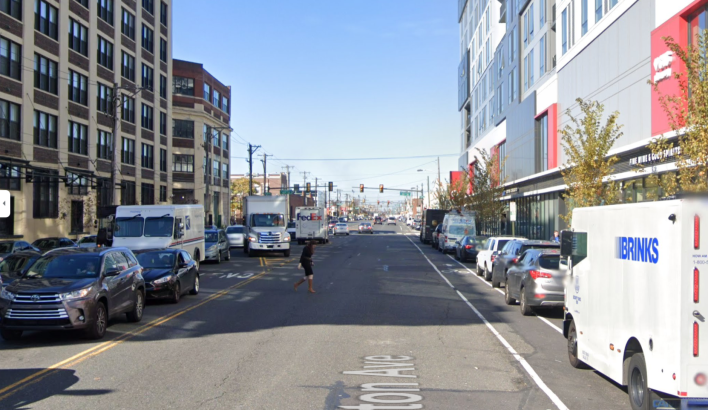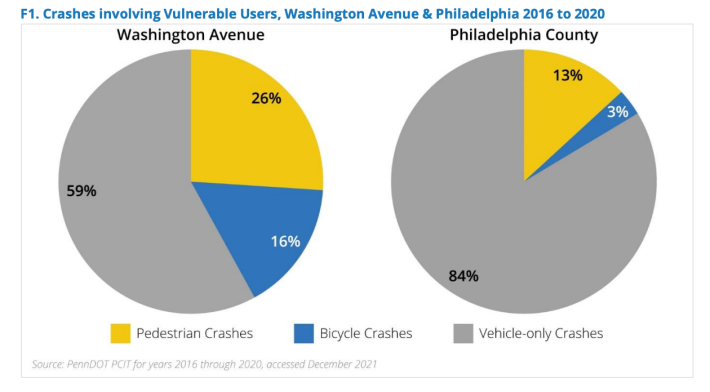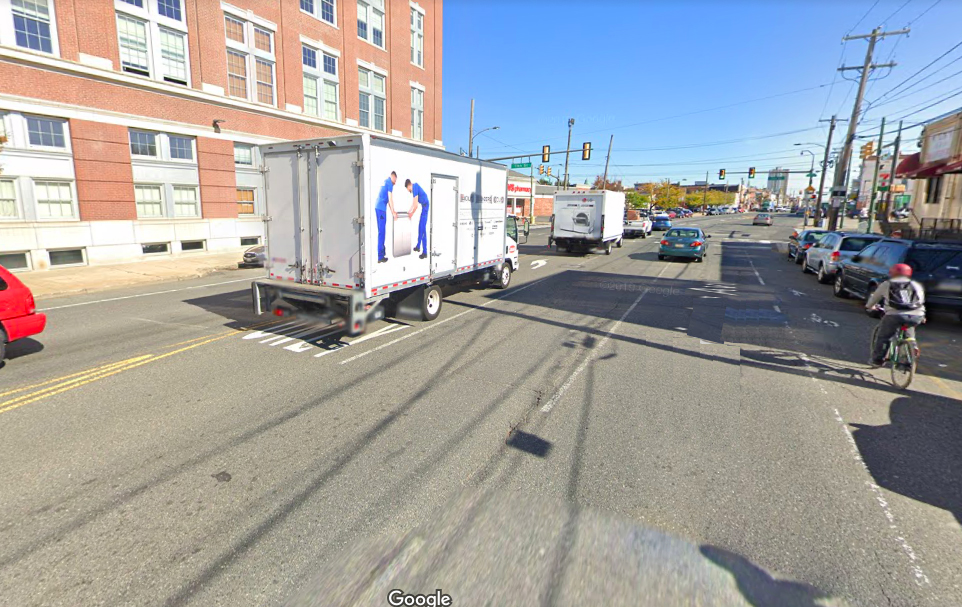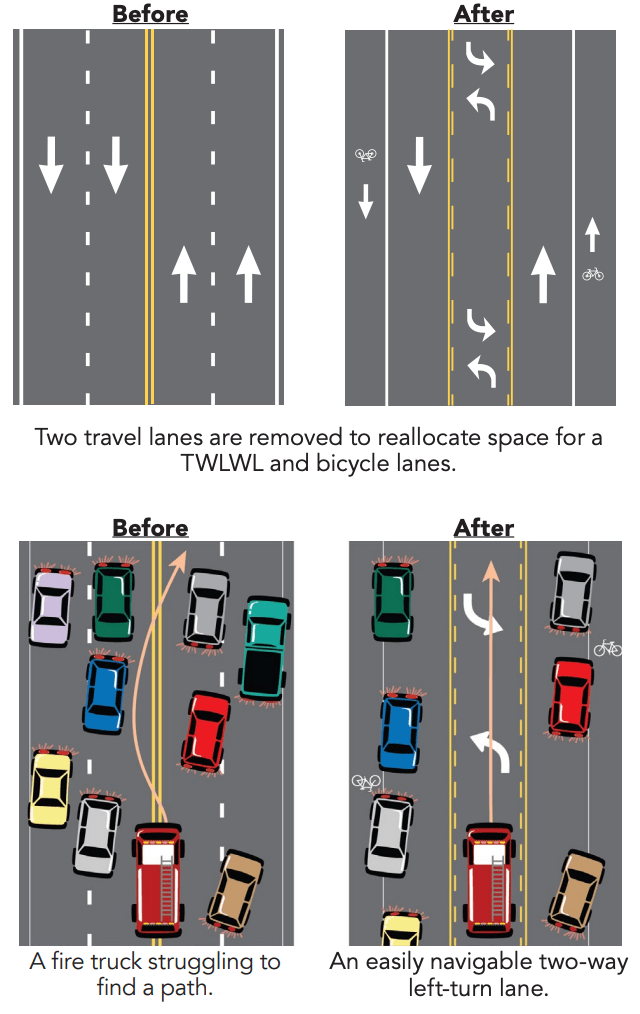Editor's note: today, we're continuing our brief series on communities that have rolled back their efforts to transform dangerous, auto-centric roads to center the needs of people on all modes, and what makes road "diets" so challenging in U.S. cities and towns. In part one, we looked at one city that's facing resistance from the top down; today, we'll look at another whose challenges are coming from the bottom up. And next, then we'll take a broader look at what strategies and reforms might help make similar projects successful in the future.
When should transportation leaders stop and listen to community members who resist road safety projects — and when should they carry on with plans to calm dangerous streets?
That question is looming large over Philadelphia, whose Office of Transportation, Infrastructure and Sustainability recently announced that it would ditch a plan to reduce a 2.1-mile segment of car-dominated Washington Avenue from five lanes to three, while adding parking-protected bike lanes and wider sidewalks. The city had committed to the three-lane plan following more than eight years of analysis and dozens of public meetings, culminating in a massive survey that the Philadelphia Bicycle Coalition say garnered "one of the largest responses to any city traffic study, ever."

Opponents of the project, though, say the survey was launched at a particularly inopportune time — March 2020, as much of the city went into quarantine — and that the 71 percent of the 5,458 respondents who support narrowing Washington are not representative of the opinions of local business owners, or the diverse residents of the quickly gentrifying neighborhood through which the road runs. An informal petition in opposition to the project started has garnered more than 2,000 signatures, and its organizers say 70 percent of them come from people in the neighborhood — though proponents say those numbers cannot be verified, and that a second informal petition in support of the project has attracted more then 3,000 signatories itself.
Still, city officials agreed that the Office of Transportation, Infrastructure and Sustainability should have done more to make sure that all residents felt heard.
“People who are Black and Brown, people who are in lower-income situations — there’s a pattern in transportation — only get asked or spoken to after decisions are made,” OTIS Deputy Managing Director Carroll told Philadephia's WHYY. “Anyone who knows anything about the history of urban transportation cannot argue with that fact. And so in a profound way, this was replicating that process.” (The agency did not respond to a request for comment from Streetsblog.)
Proponents of the Washington Avenue project, though, aren't convinced that the city's decision to nix the three-lane option will serve its equity goals in the long run— or that the city's next wave of surveying will be truly equitable either, especially if it leads to a final decision that leaves Washington Avenue wide and dangerous. The city has committed to doing some form of road reconfiguration as part of an upcoming repaving, and says that the thoroughfare may still lose one lane, but the final design will be more conducive to maintaining motorist speeds — a position that rankles local safety activists.
"I’ve always been of the mindset that street safety should not require 100 percent consensus," said James Gitto, an advocate at the Philadelphia urbanist political action committee 5th Square. "We elect leaders to make those difficult decisions to meet the needs of the community, and one of the most important needs of our community is for our kids to stop dying when they walk to school. And by the way, the people who die on this street skew heavily towards people of color, and heavily towards low-income people of color."
'Using equity as a fig leaf'
Gitto isn't the only advocate who questions the Office of Transportation, Infrastructure and Sustainability's equity rationale for overruling its own survey results — though few doubt that a more comprehensive notion of mobility justice should be at the forefront of Philadelphia's transportation decisions.
As Black leaders like Michael Carroll have long pointed out, people of color and low-income residents struggle under the weight of a long history of systemic racism in transportation projects, many of which continue to pollute, endanger, and destroy their communities. Perhaps the most famous example was the birth of the federal highway system, during which an estimated 475,000 households and more than a million people, most of whom were poor BIPOC, were displaced to accommodate the travel needs of drivers, many of whom were newly-minted white suburbanites fleeing city cores.
Projects that seek to ease the racist impacts of autocentric development though, have not always been done with the active participation of communities of color, either — or even with their consent. That was thrown into particularly sharp relief during the pandemic, when mobility justice groups like the Untokening called on cities not to "plan future projects at a time when equitable public participation is impossible."

The Washington Avenue road diet, though, had already been the subject of a public engagement campaign for close to a decade by the time Covid-19 came to Philly, and some advocates argue city leaders had a duty to finally get it across the finish line even during lockdowns — particularly if they're serious about achieving the region's goal of achieving zero traffic deaths by 2030.
That goal couldn't be more urgent in South Philadelphia, which has the fourth highest rate of biking per capita in the entire United States, thanks in part to the area's growing immigrant population. Many roads within its footprint, including this segment of Washington Avenue, are included in the city's High Injury Network, which identifies where residents are most often hurt in car crashes. Four road users died there between 2012 and 2016 alone; 16 percent of all crashes involved cyclists, more than five times the percentage in all of Philadelphia County, and another 26 percent involved pedestrians, twice the percentage in the larger community.
"This project is not just about creating safety; it’s about meeting people where they are and providing a much-needed public utility," wrote Randy LoBasso of the Philadelphia Bike Coalition.

Several multimodal advocates we spoke to suspect bike lanes and short crossing distances are being denied to Washington Avenue not because residents feel they don't need them, but because the most vocal opponents of the road diet hold particular sway with the councilpeople who govern it. Much like other communities across the U.S., Philadelphia's city council is given significant discretion over transportation decisions like road diets, and ward leaders typically defer to their colleagues regarding projects on their home turf.
Some advocates think it's time for that norm to be quashed — and for the city to commit to a definition of equity that prioritizes saving the lives of vulnerable road users in communities of color.
"At this point, I see this as equity being used as a fig leaf to double down on the inequitable policies of the last century – prioritizing cars over the safety of people," said Daniel Trubman, also of 5th Square. "Frankly, we’re seeing progressive framing and rhetoric to defend decisions that were made for anything but equity-minded reasons. ... When you look at some of these census tracts, the majority of households don’t even own cars. So I think it borders on farcical to demand that streets remain unsafe because of equity issues. I find it disgusting, and frankly, I find it cowardly."
Overlooked insights
Opponents of the Washington Avenue project, though, say that a road diet would have inequitable impacts on their communities, even if it saved the lives of BIPOC on Philadelphia streets — and that the community engagement process that led to the project has left them feeling disrespected and misunderstood. In particular, they bristle at the notion that they're enemies of street safety — or even of multimodal travel
"I wasn’t even completely against the three-lane option," said Gabriel Pechacek, founder of the Washington Avenue Association of Businesses and Residents, which was formed, in part, to oppose to the project. "I got on Street Mix and sent [the city] some modified versions of the three-lane plan that I thought might work better. I thought it was a done deal."
Pechacek, who manages an auto-body shop along Washington Avenue, certainly hoped that the road diet would be amended to maintain the thoroughfare's five-lane configuration — and he wasn't alone in that wish. He was one of a half-dozen business and community leaders who co-authored a letter to the city arguing that "Washington Avenue was intended as a thoroughfare, not a primarily residential street," and urging the agency to retain the current traffic pattern, while adopting a range of targeted safety measures instead. (Some of those would likely be welcomed by street safety advocates, like adding leading pedestrian intervals at crosswalks; others, like discouraging cyclists from using Washington at all and requiring them to maintain licenses, probably wouldn't.)
The coalition members have a range of reasons why they oppose the road diet, but all agree it doesn't represent their vision for the future of the corridor.
"The move to have Washington Avenue favor pedestrian-friendly options over commercial traffic is gentrification, plain and simple," the group wrote. "The needs of existing long-term business owners and residents are being trampled by developers' yen for greater profits. The proposed changes will lead to the loss of businesses and jobs, and the elimination of low and affordable housing in the area."
Does this happen in your city too? Where the community invests a lot of time in a planning process, arrives at a plan? And then a few powerful individuals do an end run around it at the last minute? https://t.co/eoOAklaiYC
— Angie Schmitt🚶♀️ (@schmangee) February 10, 2022
Proponents of the road diet, though, says that national data doesn't support many of the Save Washington Avenue Coalition's biggest concerns.
The Federal Highway Administration, for instance, has amassed decades of case studies that show road diets actually increase business activity by attracting walkers to neighborhoods — because walkers are significantly more likely to stop spontaneously at shops and restaurants than a driver passing by at high speeds. (In fairness to auto-body shop owner Pechacek, his customers probably don't arrive on foot.)
The agency also long ago busted the myth that road diets cause significant congestion — a fact that OTIS confirmed in its own traffic studies, which estimated no more than a 15-second delay per block at peak times, with only minimal increases on the adjacent grid streets at rush hours. The agency also disputed the notion that road diets slow down emergency response times; in many cases, the feds say road diets actually enhance them, particularly when adding center turn lanes as the Washington Avenue project would.
Philly officials face backlash over plans to redesign Washington Avenue.
— PlanPhilly (@PlanPhilly) February 11, 2022
The drama plays out amid the tensions of a changing neighborhood.
“Nobody came to people who were already here,” said one resident. “It’s called respect.https://t.co/exL5UYneOb
Concerns about the gentrification (and the many complex and urgent social problems that single word is meant to signify) are harder to counter, but a growing body of research suggests that calming streets like Washington Avenue may not have the impacts on undeserved communities that some residents fear. National studies have confirmed that the installation of bike infrastructure alone is not correlated with the displacement of people of color or the low-income, and that road diets in other communities didn't even significantly impact surrounding property values, which means they're unlikely to entice a crushing wave of new development.
For every analysis that shows the benefits of losing lanes, though, there are always at least a few case studies that suggest that road diets can either cause harm or aren't yet proven to work in certain, hyper-specific local contexts. Pechacek says OTIS told him this was the first five-to-three lane conversion ever proposed in Philadelphia, and despite other successful large road diets elsewhere, he doesn't want Washington to be their guinea pig — particularly because he thinks of the road as "primarily an industrial corridor," despite other residents' opinion that it's a former industrial corridor that's getting more human-centered every year.
"We have to actually look at data for roads that are similar to ours," he adds. "We’d have to look at roadways that have similar industrial layouts with similar traffic levels. We can’t say road diets are one-size-fits-all solution."
But even showing residents reams of data can't really give them a true sense of dignity. and co-authorship in their community — something Pechacek and his coalitionmates say they didn't get during OTIS' pandemic-era survey process. He says he receives hundreds of emails and physical letters a day, and it wasn't until the agency actually called his shop that he and many of his neighbors even knew the eight-year project was underway.
If OTIS had reached out by other methods, and treated residents like him as collaborators with deep local knowledge rather than simple permission-givers, he thinks things might be different now.
"I don’t think the community should have a say in traffic safety so much as they should have insight into how to do it right," Pechacek. "You can do a survey and be out there, but we have information about how people actually use the road that they overlooked. That’s what they should be looking for — that little bit of lost data that they needed."
The future
The Washington Avenue road diet isn't quite dead. Advocates say the city plans to release a "final-final" decision about the design of the road by March 1, and is deciding between an option that would still narrow it to three lanes in some sections and one that would reduce it to four throughout the entirety of the corridor.
"Neither side is happy now," Gitto said. "The side that tried to derail this whole thing because they don’t want any changes, well, there’s still going to be changes to this street. The side that wanted it to be safer — well, the safest option is off the table."
Gitto and his colleagues at 5th Square, though, say that there are some reasons for optimism. The PAC raised an unprecedented $10,000 in the two days after the three-lane option was rescinded, which he says they'll put towards the campaigns of candidates who will challenge city council people with a track record of killing key traffic safety projects. Trubman adds that he hopes the fracas will provoke a conversation about whether giving the council so much influence over transportation decisions is wise, and hopes that it will be a wake-up call to progressive leaders who say they support Vision Zero but struggle to actually enact life-saving projects in the real world.
Gitto adds that whatever happens next, he hopes that the city will ask itself hard questions about equity and safety — and whether conventional approaches to community engagement are achieving either.
"At the end of the day, this shouldn't be a democracy issue," added Gitto. "No one voted to have this dangerous roadway installed in the first place."







